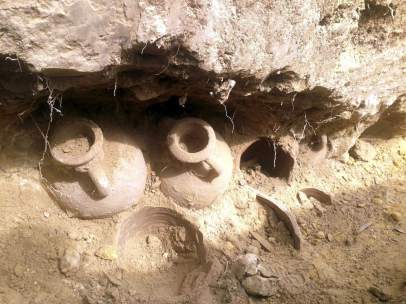
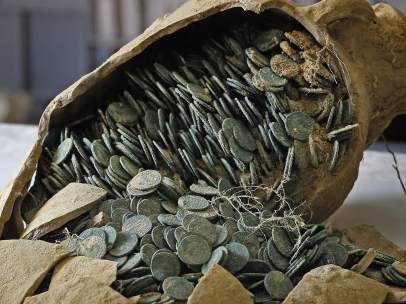
Ancient Roman and Greek Coins, page 2 (return to page 1, jump to page 3)
There can't be many around--aren't they all in museums?
Actually, there are many around. If you live in the United States it is hard to realize how common it is to dig up really old archeological artifacts in England, France, Spain, Italy, Greece, Bulgaria, Serbia, Turkey, Syria, Israel, Jordan, Lebanon, Egypt, Iraq, Iran, Tunisia, Libya and other a dozen other countries where ancient coins are found. If you were a collector in England, you would see ancient coins for sale in every coin shop because they find them in the ground--sometime in hoards of thousands together. Museums get first pick (and pay market value in England, but not other countries), but most finds are duplicates of types already in the museums, so the coins go on the market.


Nineteen amphora full of coins found in 2016 in Sevilla, Spain. Workmen were doing routine work on water lines under a street when they stumbled across 80,000 Roman coins.
This is not an unusual occurrence.
For more about why ancient coins are not rare, see here.
An academic work by Philippa Walton and Sam Morehead says about finds in Roman Britain, "Over the past 200 years, more than 2,570 coin hoards have been found, and the numbers continue to rise, particularly since the introduction of Treasure legislation in 1997. These hoards are complemented by records of more than 180,000 stray losses and site finds collected throughout England and Wales by the Portable Antiquities Scheme (www.finds.org.uk) and the Iron Age and Roman Coin Finds from Wales Project (Guest and Wells 2007) as well as more than 450 assemblages found during research excavations and development control projects published both individually and as summaries (cf. Reece 1991; Walton 2012)." And, that's just recorded finds from one country among a long list of countries where coin hoards are found.

Where? I don't see it.
That's the point. Hoards are often found in the middle of nowhere--not pre-exisiting archaeological sites.
Are you saying there were a lot of coins produced in ancient times?
Yes. There are many scholarly articles that discuss ancient-coin production. For example, one issue of Roman Republican silver denarii from 82 BC is particularly easy to study because the dies were engraved with consecutive Roman numerals from 1 to 419 (Over 3200 extant examples of that one issue have been photographed and studied). The conclusion is the output of Roman Republican denarii in 82 BC was on the order of 30 million coins. That's just one year and does not count the large output from the many Greek mints operating that year. Scholars are convinced that the output of coins each year under the late empire was many times that large. In the 300s the Romans had up to sixteen large active mints simultaneously. Probably billions of coins were produced in antiquity. Many still survive.
I've made my point, but if you want to see more about how common ancient coins really are, look here.
If they are found over there, how can I buy them here in the US?
There are coin dealers in the US who specialize in ancients. Lots of collectors and dealers buy coins over there and bring them back here. After all, coins are small and easy to carry across the Atlantic! Also, it is easy to buy from British and European dealers on the web and they will mail them to you.
Aren't they very expensive?
No, they're not. Well, some are. You can spend $100 or $500 on a great coin if you want, but very many interesting low-grade ancient coins are available for about $5-$15 each. Some of the most common ones can be found in very attractive condition for $10 to $40.
Prices are, of course, set by supply and demand. If you want a great coin, supply is adequate. However, if you want an excellent late Roman (3rd - 4th century) coin, supply is huge and demand is not. There aren't that many collectors. Consequently, prices are low.
Designs. Unlike modern coins, there is a huge number of different designs. Roman coins usually have a head in profile on one side (the obverse, the "head" side). It could picture a Roman or Greek god.
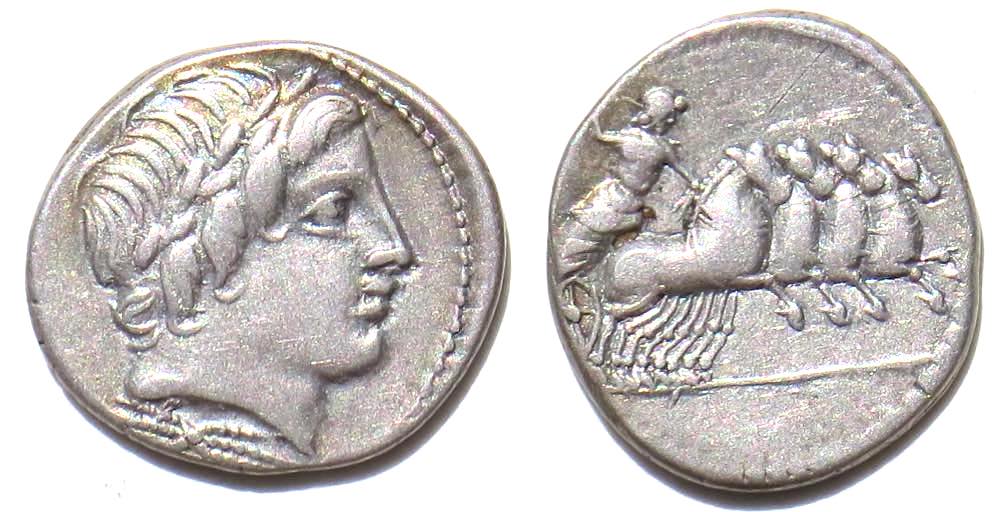
Apollo / Chariot on a Roman Republican silver denarius (20mm diameter) struck 86 BC. Jupiter drives the "quadriga" (four-horse chariot). Apollo wears an oak-wreath. Just below his neck is a thunderbolt.
Ancient coins depict many animals.

Lion, radiate, holding a thunderbolt in its mouth, on a silver coin of the Roman emperor Caracalla (sole emperor 211-217 AD). His portrait and some of his titles are on the obverse. This denomination, introduced in 215 AD, is technically called an antoninianus, but also (more simply!) called a "radiate" because of the radiate crown on the emperor's head which distinguishes it from the silver denarius which had been minted for hundreds of years.
The next reverse shows a goddess.

Diana, the huntress, known to the Greeks as Artemis, depicted in a short hunting skirt, with her bow and arrow and her hound. The coin is a "Roman provincial" copper piece (28mm diameter, substantially larger than a quarter, and with a lovely green patina) struck for Macrinus, Roman emperor 217-218AD, at Nicopolis ad Istrum (Bulgaria). The legend is in Greek and names Macrinus (2:00 - 5:00) on the obverse.
Roman and Greek coins often show battle scenes.
 This is a quarter-sized copper coin of Constantius II, Roman emperor from AD 337 to 361.
This is a quarter-sized copper coin of Constantius II, Roman emperor from AD 337 to 361.
Roman imperial coins have legends which name the emperor and give some of his titles. This one that says "DN CONSTANTIVS PF AVG" which you can read around his head.
On this reverse is a battle scene with a very large foot soldier thrusting his spear downward into a smaller (Persian) horseman who turns back to ward off the spear as his tiny horse falls and begins to tumble over its head. The reverse legend
FEL TEMP REPARATIO
translates to "Happy times are restored!" or "Happy times are here again!
The "ANH" below the ground line is a mint mark of Antioch, one of the largest cities in the empire.
This is a common coin, available for $25 - $60 in excellent condition, and $10 in lesser grade, but still okay.
Women are on coins.
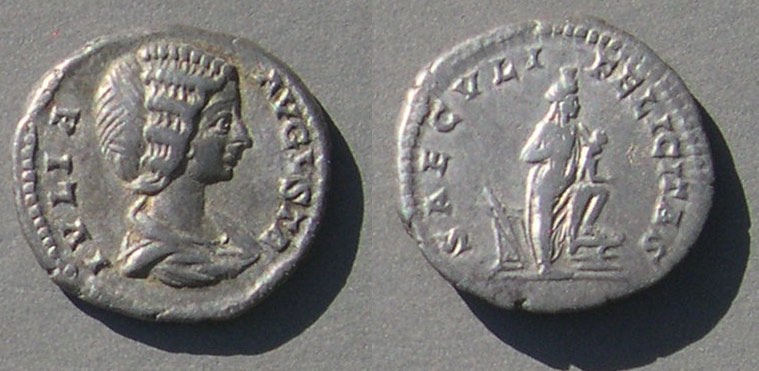
Julia Domna (d. 217) was the wife of Septimius Severus (193-211) and powerful in her own right. This is a denarius. 18 mm.
IVLIA AVGVSTA (Julia, empress)
SAECVLI FELICITAS (happy age) Isis suckling Horus.
There are a huge number of other designs.
Many Greek coins are beautiful.
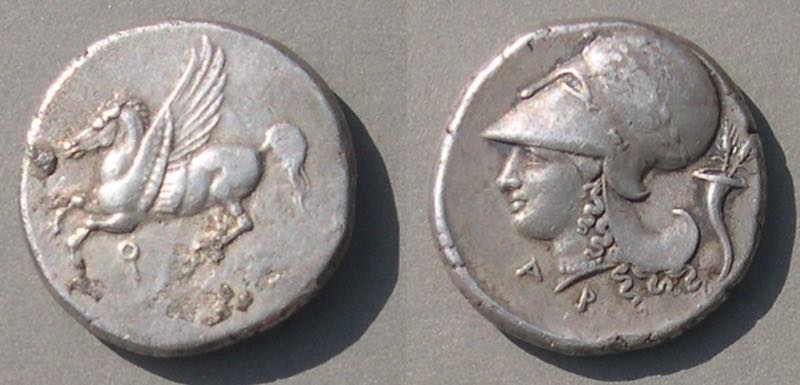
A silver stater of the city of Corinth, struck c. 350-315 BC.
21 mm. It has the diameter of a nickle, but is thicker.
Pegasus flying left
Athena wearing a Corinthian helmet tipped back.
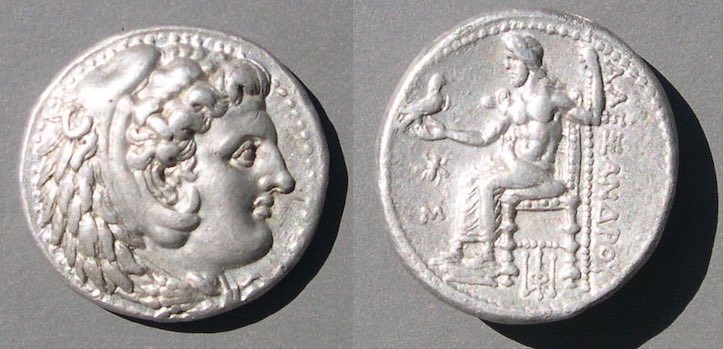 A massive tetradrachm of Alexander the Great (336-323 BC), struck in Babylon while he was there.
A massive tetradrachm of Alexander the Great (336-323 BC), struck in Babylon while he was there.
A tetradrachm. 26-24 mm. Larger than a US quarter and twice as thick.
Hercules head right in lion skin (This is not a portrait of Alexander).
Zeus seated left holding eagle and scepter. His name downwards behind in Greek.
Many Greek coins picture animals and birds such as lions, horses, eagles, stags, snakes, crabs, and dolphins. (You can even find an octopus!) One common type that seems odd to modern sensibilities is this large Greek coin minted in the city of Pergamon.
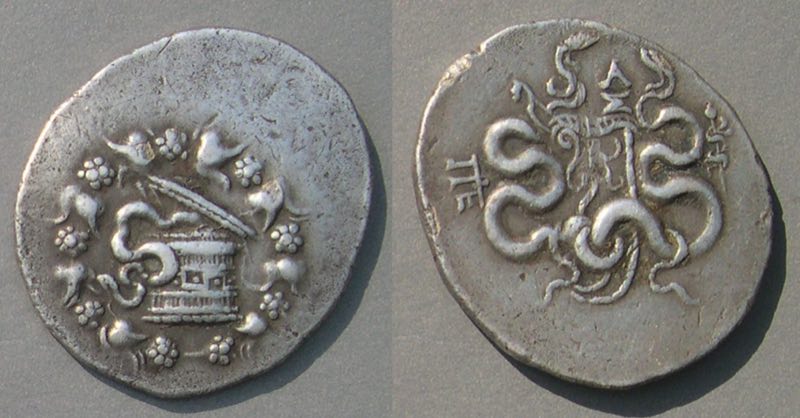 Remarkably, snakes are common on ancient coins. Here is a coin where snakes dominate the type.
Remarkably, snakes are common on ancient coins. Here is a coin where snakes dominate the type.A silver "cistaphoric tetradrachm" (30-26 mm, much larger than a quarter) minted at Pergamon in Turkey c. 123-104 B.C. after the Romans created the Province of Asia. Some numismatists have called this the ugliest Greek coin type. Certainly the snakes are not appealing. (But they are interesting.) The obverse has the "cista mystica" or sacred chest with a snake crawling out and the reverse has two snakes around a bow case. Needless to say, snakes played a role in the local religion, and pages could be written on what role the snakes played in the cult. The mint name is abbreviated into a monogram "Pi epsilon rho" [PERgamon] on the left of the reverse. This type was issued in vast quantities from numerous Asiatic mints.
But there are hundreds of unusual and interesting types -- far too many to be mentioned here.
How can I find a dealer who sells ancients?
I recommend the "ancient-coin mall," vcoins.com and my own small site, augustuscoins.com. The mall has over 100 dealers at one site and a very good search engine. If you want to buy fixed price coins, try it. Many ancient coins are offered on eBay (go to "Coins" and then "Ancient"), but do not buy there without reading my page about eBay first. Be aware that some (many) eBay coins are fakes and many are mis-described. You need to be very careful with eBay.
Here is a page of links to dealers. You will see there are very many! Ancient coins are historcial, beautiful, and fascinating, but they are common, not rare.
Greek coins are not as common as late Roman coins, but some attractive Greek silver types are occasionally found in hoards of over a hundred pieces (sometimes over a thusand) and it is fair to say that many attractive ancient Greek coin types are common.
 Bohemund helmeted, in chain mail
Bohemund helmeted, in chain mailYes, you will. Roman legends are in Latin which uses our usual A, B, C, ... alphabet. Many of the words will remind you of English, and all you have to do is learn the most common names, titles, words and abbreviations that appear on coins. There are not that many.
Greek coins generally have very short legends naming the city or king, in Greek. Greek has many letters like ours, but some have different letter shapes (for example Δ (delta) for D). You get used to it quickly. Or you can stick to Roman coins.
I've looked at a few and I don't know how to even pronounce the names and coin-terms!
This turns out not to be a problem. There are pronunciation guides (A Latin Pronunciation Guide for Numismatists), but most collectors don't bother trying to get them "right." You can try and sound them out and that will be close enough. Here's why.
They are metal, right?
Right. They were minted in silver, copper, or gold. Of course, the lower denominations in copper and silver are more common. Most are from the size of a dime to the size of a half dollar, but thicker.
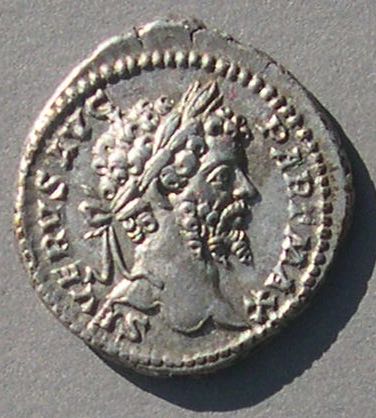 Some don't look perfectly round.
Some don't look perfectly round.
That is the result of the ancient minting technique. Coins were made by using a heavy hammer to strike coin blanks between two dies. Like squeezing clay between your fingers, the pressure often caused the blank to elongate or even split at the edges. (Now, modern coins are forced to become round by striking them inside a round collar.) For example, look at the top edge of the silver denarius (Septimius Severus, 193-211 AD, 18 mm diameter) you saw on the previous page and again here. It is not exactly round.
The Greek silver coin of Pergamon you saw above is far from round.
What were they worth?
Small coins were pretty valuable then. Silver and gold were rare and valuable metals and the coins were valued for the metal they contained. In Greek and Roman times, silver coins the size of a dime (that are common today) were worth a full day's pay for a laborer (and most workers were laborers). So, that might be, say, $40 in today's money. You could support yourself and a small family on that. You could buy enough wheat for 25 pounds of bread or 10 pounds of olive oil (28,000 calories of nutrition!) with one small silver coin (a denarius).
What do people collect?Most ancient coin collectors collect Roman coins, and maybe a quarter collect Greek coins. Many start out buying one or two because they are so old, and then they delve into the history. Roman coin collectors like the stories of the emperors and often try to get one of each emperor. You can find excellent portraits of over 30 different emperors and Caesars (and some of their wives and mothers) for less than $50 each, some for much less.
Many collectors start with coins from the third and fourth century AD because they are old, inexpensive, and attractive.
 Here is a high-grade $30-$80 coin of Roman emperor Probus, 276-282 AD, to the right. 23 mm diameter. It's pretty spectacular, but common and not expensive.
Here is a high-grade $30-$80 coin of Roman emperor Probus, 276-282 AD, to the right. 23 mm diameter. It's pretty spectacular, but common and not expensive.
By the way, from Augustus (27 BC - 14 AD) to the "fall" of Rome in the fifth century AD there were about 70 emperors acknowledged at Rome, all with portrait coins, and another 100 or so sons, wives, mothers, and usurpers with portrait coins.
Of course, many collectors settle on a more limited time period. I have a friend who concentrates on the second century, another who concentrates on the fourth, one who collects Roman Republican, one who collects Byzantine coins, one who collects Greek silver coins, one who emphasizes coins of the ancient Near East, one who prefers Roman coins of the "middle bronze" denominations, and I know of a collector who concentrates on coins of a single emperor! There are many possible themes (Republican coins, Christian reference coins, military types, gods and goddesses, mythological types, animals, etc., etc.) -- and no one will tell you what you are "supposed" to like!
If you want to get a set, consider getting portraits of each of the "12 Caesars" (Julius Caesar through Domitian). My first long-range goal was to get a set of the 70 rulers from Augustus to the fifth century who were recognized at Rome (minus a few that were rare and too expensive). A set of five coins of the "Five good emperors" of the second century would be easy to complete. The group could be supplemented later with coins of the wives and relatives for whom they minted coins.
Many collectors like to emphasize a particular denomination, for example, the radiate silver coins introduced by Caracalla in 215 and issued by numerous emperors and Caesars until 294.
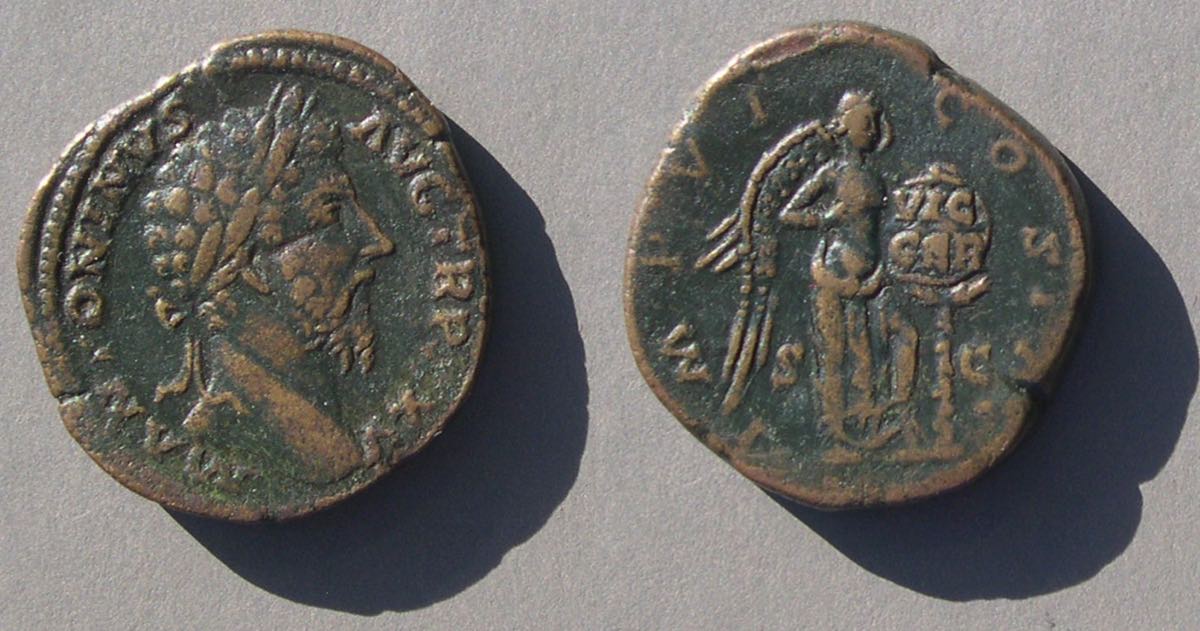 Collectors like the history. Roman coins are government documents that often combine history with portraits. Reverses may refer to victories (Marcus Aurelius, 141-180, notes "VIC GER" for a victory against the Germans on this coin), the emperor's travels, the emperor's family, governmental policies, donatives, or other contemporary events.
Collectors like the history. Roman coins are government documents that often combine history with portraits. Reverses may refer to victories (Marcus Aurelius, 141-180, notes "VIC GER" for a victory against the Germans on this coin), the emperor's travels, the emperor's family, governmental policies, donatives, or other contemporary events.
Greek coins do not lend themselves so easily to completing sets. I have heard of people wanting one coin from each city St. Paul visited. You could collect one beautiful coin from each mint city in Sicily. There are many potential sets, but no particular set is well-known and heavily collected like the run of Lincoln cents or Morgan dollars. You could make your own list of coins and aim to complete it. But, if your strongest desire is to collect something where you can "fill that last hole" in the collection, I don't think Greek coins are for you.
I assembled an illustrated page of some possible collecting themes here. Here is a link to a long thread on CoinTalk where collectors showed coins that fit various themes. Many collectors answered this question on an e-mail list over a decade ago. I have assembled the fascinating (written) answers here.
Continue on the next page (page 3) of Ancient Roman and Greek Coins, FAQ.
books, ancient coin websites, lists, shows, Julius Caesar, Nero, prices,
inexpensive coins, women, grading, fakes, buying, proper prices, selling, buying at auctions,
eBay buying and selling, web sites for talking with e-friends, how to value coins, books to buy, favorite educational links
Return to the beginning of page 1 of Ancient Roman and Greek Coins, FAQ.
Return to the top of this page (page 2) of Ancient Roman and Greek Coins, FAQ.
Go to the overall main Table of Contents page of my site.